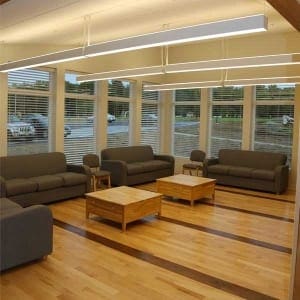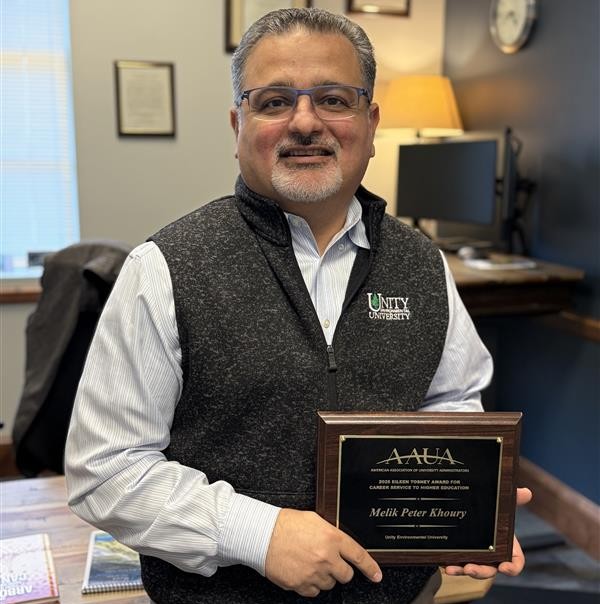
Ask an alum, a long-serving faculty or staff member, or residents of the Town of Unity about the history of Unity College and one theme rings clear – the physical presence of campus facilities has improved by leaps and bounds in a very short time.
The addition last year of Clifford Hall – built to LEED Silver standards honoring the late Bert Clifford, a Unity College founder and well-known local philanthropist – will be joined this year by another high-efficiency residence hall: Unity Two, the college’s first residence hall using air source heat pumps to regulate climate control.
Joining TerraHaus – the first college residence hall in the U.S. built to the Passive House standard – Unity’s three newest residence halls are providing comfortable accommodations. Especially as Unity continues to meet and exceed its enrollment goals, the imperative has been to construct 21st-century housing that supports a vibrant, diverse campus of learners within the framework of Sustainability Science.
“Over the past few years, we have made a dedicated effort to provide quality upper-class housing options. Clifford Hall and Unity Two provide living arrangements and amenities that our upper-class students desire,” Dean for Student Affairs Gary Zane said. “The result – we have a record number of juniors and seniors now living on campus, and have a record residential population overall.”
“As with all of our campus improvement projects, we listened to the needs and preferences of students,” Unity College President Dr. Stephen Mulkey said. “Clifford Hall is a comfortable residence hall with the amenities our students have told us they want, and it provides features like wireless technology throughout that support study and experiential learning.”
Stephen Nason, Director of Residence Life and Assistant Dean for Student Affairs, said that when Unity Two opens this fall, it will “continue Unity College’s commitment to having 21st-century housing designed for upper-class students.”
“At Unity College each year, more and more junior and senior students are choosing to stay on campus because of the community and convenience,” Nason said. “Unity Two greatly helps meet this growing on-campus demand from juniors and seniors.”
But forward-thinking residence halls are only the latest and most visible example of the college’s march toward modernity on a campus once renowned for its hardscrabble, do-it-yourself environment.
“What’s taken place – especially in the last three years, is an undeniable modernization and upgrade of all our critical facilities, from residence halls, to classrooms and laboratories, to research facilities and places for student activities,” said Mulkey, “It’s no overstatement to say it’s been a small renaissance on campus.”
In the past three years, renovations were made to the Koons Hall Research Laboratory, including the addition of geology, chemistry, and clean laboratories. Wyman Commons dining hall was extensively renovated and expanded, with a unique Mongolian grill added to its all-you-care-to-eat menu offering traditional, meat-free, vegan and other dietary specialties. New lighting, classroom furniture, and renovated bathrooms have been added to the Student Activities Center.
Significantly, Unity also added a center for sustainable agriculture by virtue of the gift of McKay Farm and Research Station – an agricultural greenhouse facility in Thorndike that serves as a direct extension of the 225-acre campus, providing the community with educational and entrepreneurial opportunities.
The gift, along with five years of financial support, was given by Isabel McKay and Rick Thompson, and is the second
largest cash gift donation in the college’s history.
“The donation of McKay Farm and Research Station will help the college develop and model replicable solutions for environmental challenges, in addition to creating a marketplace presence to serve the community,” said Mary Saunders Bulan, the director of the facility. “Students will learn invaluable business management and administrative skills necessary to operate a successful agricultural business.”
“As a center for innovative projects and research, challenges faced by rural agricultural enterprises in New England will be addressed including energy costs, compensation for agricultural workers, a challenging climate, and sparse population density,” Saunders Bulan said.
Another repurposed space – the Unity College Center for the Performing Arts – is enjoying its own renaissance with the potential to transform the region’s cultural offerings and tie the campus even more closely to the town and region. In February, Grants to Green Maine gave $39,520 to upgrade energy systems and controls at the redeveloped farmhouse and barn that now houses administrative offices, the Leonard R. Craig Gallery, and a 200-seat theater (for more see page 30).
The grant will enable the college to replace outdated air conditioning units with air source heat pumps, replace incandescent and CFL lighting with LED, insulate the attic to R-70, and update monitoring and control equipment to enable remote energy systems regulation from any web-linked computer. The project will cut energy use at the facility, institutional operating costs, and fossil fuel consumption to address climate change.
The person who’s best witnessed the transformation of Unity’s physical plant says it has been a whirlwind of positive news for the students who attend.
Director of Facilities and Public Safety Daniel LaForge said the physical plant of the campus has grown by more than 44,000 square feet in the last five years, and that the new spaces are of higher quality in construction and user functionality.
“In the past four years, Unity College has invested heavily in the infrastructure, appearance, and efficiency of its buildings,” LaForge said, “and now increased enrollment is evidence that the investment is paying off.”



